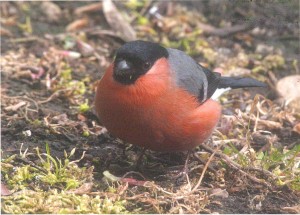 The bullfinch, or common bullfinch as it should be called, is similar in size to the house sparrow but is plumper and has a large head, thick neck and stout beak. The males are one of the easiest birds to identify as they look predominately rose pink on their undersides and side of neck. The upperparts are a mixture of grey and black whilst the contrasting white rump is partly seen at rest but dominate when the bird is in flight. The underside of the female is pinkish brown whilst the upperparts of pale grey and black and the female also has a conspicuous white rump. The males and females moult between July and October but, interestingly, the males do not have the duller Autumn plumage that is found in many other finches
The bullfinch, or common bullfinch as it should be called, is similar in size to the house sparrow but is plumper and has a large head, thick neck and stout beak. The males are one of the easiest birds to identify as they look predominately rose pink on their undersides and side of neck. The upperparts are a mixture of grey and black whilst the contrasting white rump is partly seen at rest but dominate when the bird is in flight. The underside of the female is pinkish brown whilst the upperparts of pale grey and black and the female also has a conspicuous white rump. The males and females moult between July and October but, interestingly, the males do not have the duller Autumn plumage that is found in many other finches
Despite their size and conspicuous plumage bullfinches tend to be rather secretive but this is because they like undergrowth in woodland, straggly hedges, thickets and shrubby areas. They will come into gardens but generally they do not visit feeders or feed on the ground. This is because their main food at certain times of the year are the buds from various trees which in the Highlands include hawthorn, wild cherry and blackthorn. Other tree buds include ornamental trees and fruit trees which bring these attractive birds into gardens. Their liking for the buds and flowers of fruit trees brought them into conflict with commercial orchards down south. At one time licences were issue to kill many thousands of bullfinches but the birds are now fully protected at all times. However, they may be competitively exhibited or sold if captive bred and fitted with an approved close ring.
Bullfinches have an unusual breeding habit as they will nest in loose colonies where a few pairs will nest together in dense cover such as blackthorn bushes. Their nest is one of the smallest of any small birds in the Highlands as it is a very flimsy looking structure. It is constructed of a thin layer of fine twigs with moss and lichen and a neat small cup made of roots and hair. The birds are very sedentary and ringing has shown that in the Highlands most birds stay within a few miles of where they bred. In the Highlands there is a slight complication as in some year bullfinches migrate from east to west across the north Sea and small numbers are seen in the Northern isles and along the east coast. These are birds from Scandinavia and further east and they are a different species and are noticeably larger than the British birds.
The bullfinch is on the red list of birds in Britain which means it is one of the threatened species because its numbers have fallen so drastically in recent years. In Britain as a whole the numbers fell by 50% during 1975-2000. These changes have also occurred in parts of Scotland especially in intense arable areas. In some parts of Scotland, including the Highlands, the birds seem to have maintained their numbers. The latest Highland Bird Report for 2006 states that it is a “Locally common breeder in east, but scarce in north and west.” This is interesting as the famous poet, Norman MacCaig wrote a poem about his experience at Lochinver north of Ullapool. The poem was written in December 1980 and is called “Bullfinch on guard in a hawthorn tree”. The poet talks of “ The gentle sun cobwebs brightly/his black cap, his crimson breastplate”. Scots names for the bullfinch include Alp, Awp, Bullie, Coallyhood whilst the Gaelic name is Deargan-coille meaning “red stain of the woods”.
